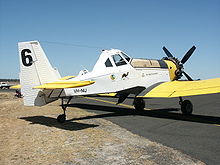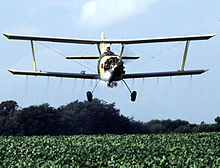- Aerial application
-
Aerial application, commonly called crop dusting, involves spraying crops with fertilizers, pesticides, and fungicides from an agricultural aircraft. The specific spreading of fertilizer is also known as aerial topdressing.
Agricultural aircraft are often purpose-built, though many have been converted from existing airframes. Helicopters are sometimes used, and some aircraft serve double duty as water bombers in areas prone to wildfires.
Contents
History
Aerial seed sowing 1906
The first known aerial application of agricultural materials was by John Chaytor, who in 1906 spread seed over a swamped valley floor in Wairoa, New Zealand, using a hot air balloon with mobile tethers. Aerial sowing of seed has continued on a small
Crop dusting 1921
The first known use of a heavier-than-air machine occurred on 3 August 1921.[1] Crop dusting was developed under the joint efforts of the U.S. Agriculture Department, and the U.S. Army Signal Corps's research station at McCook Field in Dayton, Ohio.[1] Under the direction of McCook engineer Etienne Dormoy, a United States Army Air Service Curtiss JN4 Jenny piloted by John A. Macready was modified at McCook Field to spread lead arsenate to kill catalpa sphinx caterpillars at a Catalapa farm near Troy, Ohio in the United States.[1] The first test was considered highly successful.[1] The first commercial operations were begun in 1924, by Huff-Daland Crop Dusting, which was co-founded by McCook Field test pilot Lt. Harold R. Harris.[1] Use of insecticide and fungicide for crop dusting slowly spread in the Americas and to a lesser extent other nations in the 1930s and 1940s.
Top dressing 1939-1946
Aerial topdressing, the spread of fertilizers such as superphosphate, was developed in New Zealand in the 1940s by members of the Ministry of Public Works and RNZAF, led by Alan Pritchard and Doug Campbell - unofficial experiments by individuals within the government led to funded research. Initially fertilizer and seed were dropped together (1939), using a window mounted chute on a Miles Whitney Straight, but by the end of the 1940s different mixtures of fertilizer were being distributed from hoppers installed in war surplus Grumman Avengers and C-47 Dakotas, as well as some privately operated de Havilland Tiger Moths in New Zealand, and the practise was being adopted experimentally in Australia and the United Kingdom. Crop dusting poisons enjoyed a boom after World War II until the environmental impact of widespread use became clear, particularly after the publishing of Rachel Carson's Silent Spring.
Water bombing 1952
Aerial firefighting, or water bombing, was tested experimentally by Art Seller's Skyways air services in Canada in 1952 (dropping a mix of water, fertilizer and seed), and established in California in the mid 1950s.
Night aerial application 1973-present
Crop dusting at night is mostly liquid spray and is conducted in the Southwest U.S. deserts. The rising cost of pesticides and increasing immunity built up by continuous spraying reduced the effectiveness of spraying in daytime. In high temperature areas, the insects would travel down in plants in daytime and return to the top at night. The aircraft — both fixed wing and helicopters — were equipped with lights, usually three sets: Work lights were high power and aimed or adjustable from the cockpit; wire lights were angled down for taxiing and wire or obstruction illumination; and turn lights were only turned on in the direction of the turn to allow safe operation on moonless nights where angle of entry or exit needed to be illuminated. These aircraft were equipped with pumps, booms, and nozzles for spray application. Some aircraft were equipped with an elongated metal wing called a spreader, with inbuilt channels to direct the flow of dust such as sulfur, used on melons as a pesticide and soil amendment. Very little pesticide dust was used day or night in comparison to spray, because of the difficulty in drift control. Workers on the ground, called "flaggers", would use flashlights aimed at the aircraft to mark the swaths on the ground; later, GPS units replaced the flaggers due to new laws restricting use of human flaggers with some pesticides.
According to the U.S. Bureau of Labor Statistics, in 2005 U.S. cropduster pilots earned an average annual wage of $63,210.
Environmental and human health issues
The aerial application industry is seemingly plagued with contradictory studies, some of which are negative and damaging and some are positive and show how the industry has evolved to become modern day environmental stewards. As with pesticide application in general, crop dusting is associated with a number of environmental concerns, including spray drift, soil contamination, water pollution, and occupational health concerns. Pesticide manufactures are continually evolving to address these concerns. In the infancy of the pesticide era little was known about the environmental impact of using pesticides. Over time it became evident that better chemical compounds and more focused stewardship on behalf of the applicator were going to have to be researched and implemented. Recently, pesticide manufactures have developed new products that are designed to be safely metabolized when applied to prevent any unwanted or damaging environmental impacts; these new chemical compounds are referred to as “soft chemicals”. All crop protection products must meet tough safety standards. Only one in 20,000 chemicals actually survives the 8-10 year process of development, testing, and registration by the U.S. Environmental Protection Agency (EPA). Costs to test a pesticide's safety can range in price from $160 to $200 million. Nearly 900 scientists and program officials from the EPA make sure that products are properly registered to comply with federal law. Once on the market, they are monitored by the EPA, the Food and Drug Administration (FDA) and state pesticide enforcement agencies. This stringent regulatory system ensures the safety of our food, the safety of the products to the environment, to water and to the farm workers that mix, load and apply the products.[2]
Another concern is that the aerial application of pesticides can lead to Pesticide resistance by insects, and is thus not a sustainable practice, however this is more to do with outdated farming practices and not the actual pesticides themselves. Modern day farming utilizes Integrated pest management (IPM) in order to reduce or eliminate pesticide resistance.
In the U.S. in 1970, lawsuits and court cases involving spraying of pesticides, such as aerial application in commercial agriculture were a growing area in law, combining areas such as negligence, products liability, strict liability, statutory regulation and commercial law.[3] Environmental and human rights issues associated with crop dusting is greatest in developing countries, where government oversight is weaker or absent, few safety practices are used, and chemicals are used that are banned in most developed countries.
This has led to many developments to mandate the proper dispersal of pesticides among all users. Aerial application specifically has improved equipment and techniques to provide accurate and effective delivery of crop protection products. In the 1960s the National Agricultural Aviation Association (NAAA) was established to foster industry development to the highest standards. Recently, NAAA developed the Professional Aerial Applicators Support System (PAASS) to educate pilots about safety, security and drift mitigation. PAASS is committed to reaching every aerial applicator in the U.S. with the latest information regarding these issues. In addition, the NAAA works with the federal government to invest in researching, developing and testing aerial application technologies to strengthen the safe application of crop protection products by air. Since the programs implementation statistical data suggests a substantial decreased to number of pesticide related incidences.
Crop dusting involving arsenic powders has been implicated in Bowen's disease.[4] However, lead arsenic has not been used by aerial applicators or in any other form of agriculture for three decades because of the adverse affects to human heath that were not as well known when the powder was legal. There has been an ongoing debate about the effects of consuming food that has been treated with pesticides. Often the consumers receive conflicting data on this topic and find themselves in the crossfire of politically and emotionally charged facts pertaining to the pros and cons of pesticides.
The American Cancer Society states: "Many kinds of pesticides are widely used in agriculture in the production of our food supply. People who eat more fruits and vegetables, which may contain trace amounts of pesticides, generally have lower cancer risks than people who eat fewer fruits and vegetables. Pesticides play a valuable role in sustaining our food supply. When properly controlled, the minimal risks pesticides pose are greatly overshadowed by the health benefits of a diverse diet rich in foods from plant sources."
“Aerial application helps make it possible for us to have these fresh fruits and vegetables year round. Pesticide use has resulted in increased availability and a variety of low cost, fresh fruits and vegetables year round. This has had significant impact on human health because there is strong evidence that increased consumption of fresh fruits and vegetables is associated with a reduced risk of chronic disease, including many cancers. Crop protection products also play a role in enhancing the safety of the food supply by reducing levels of natural toxins, such as mycotoxins and reducing the potential for contamination of fresh produce by food borne human pathogens”.[5]
See also
- Pesticide application
- Sprayer
- Ultra-low volume spray application
- Chemtrail
- [2] National Agricultural Aviation Association
References
- ^ a b c d e Johnson, Mary Ann. McCook Field 1917-1927. Landfall Press, Dayton, Ohio: 2002. ISBN 0-913428-84-1, pp. 190-191.
- ^ [1] National Aerial Application Association (NAAA).
- ^ William T. Birmingham; Jon L. Kyl, "Legal and Practical Aspects of Pesticide Spraying Cases", Defense Counsel Journal, (1970)
- ^ H. Luchtrath, "The consequences of chronic arsenic poisoning among Mosalle wine growers: Pathoanatomical investigations of post-mortem examinations performed between 1960 and 1977", Journal of Cancer Research and Clinical Oncology, No. 105, pp. 173-182 (1983)
- ^ http://www.agaviation.org/content/industry-faqs#safe (NAAA)
- Johnson, Mary Ann. McCook Field 1917-1927. Landfall Press, Dayton, Ohio: 2002. ISBN 0-913428-84-1, pp. 190–191.
Categories:- Agriculture
- Occupations in aviation
- Firefighting equipment
Wikimedia Foundation. 2010.





